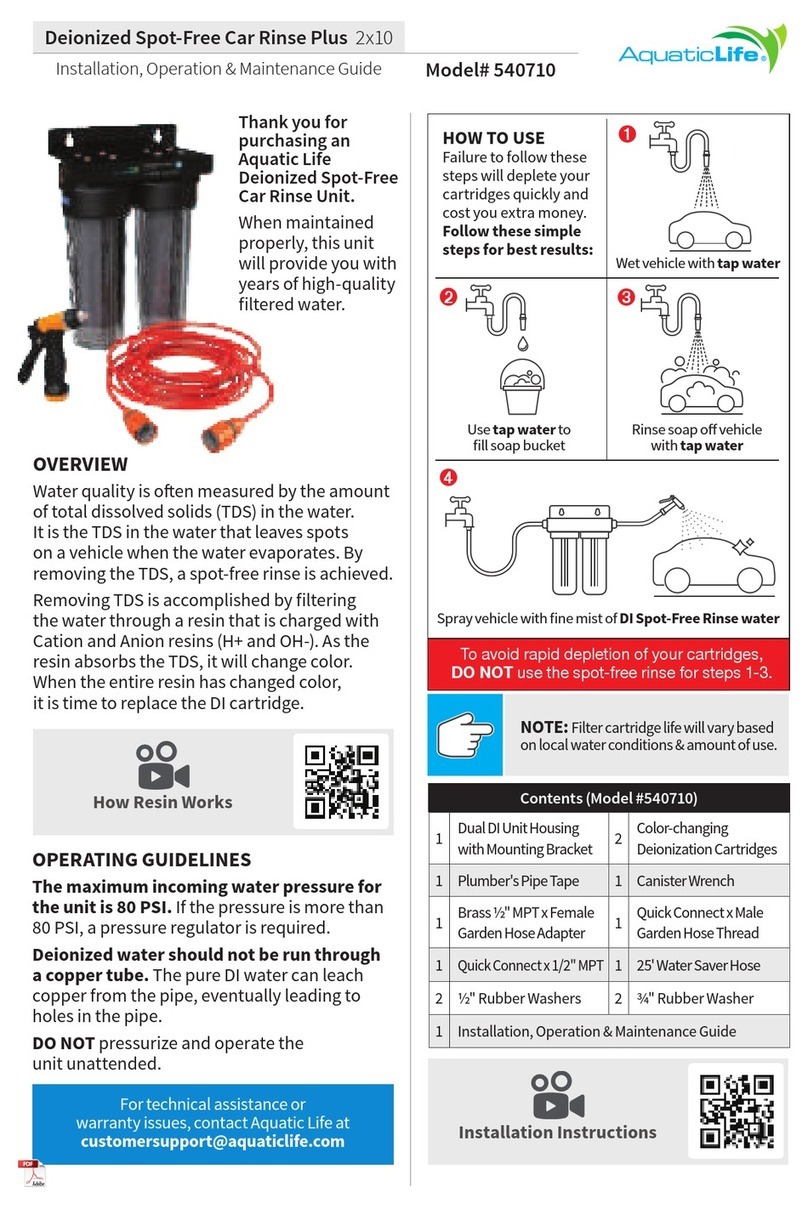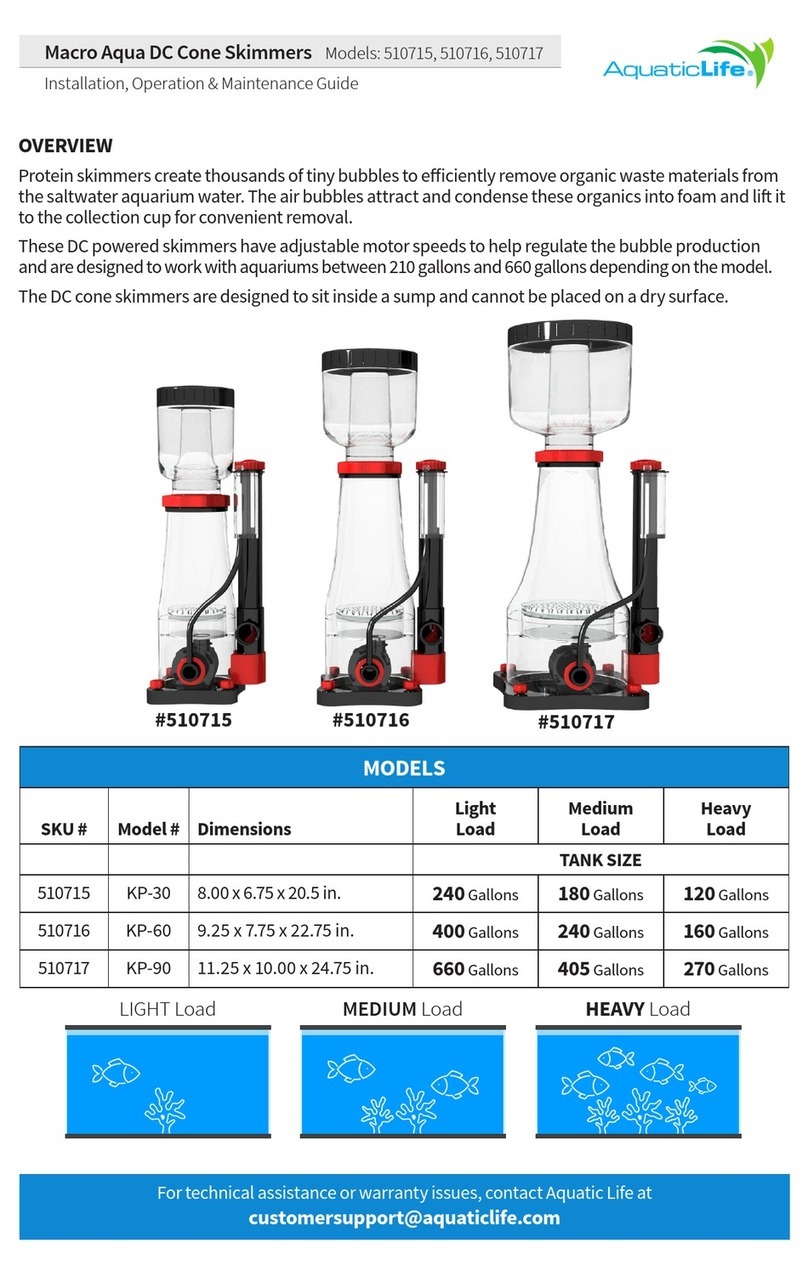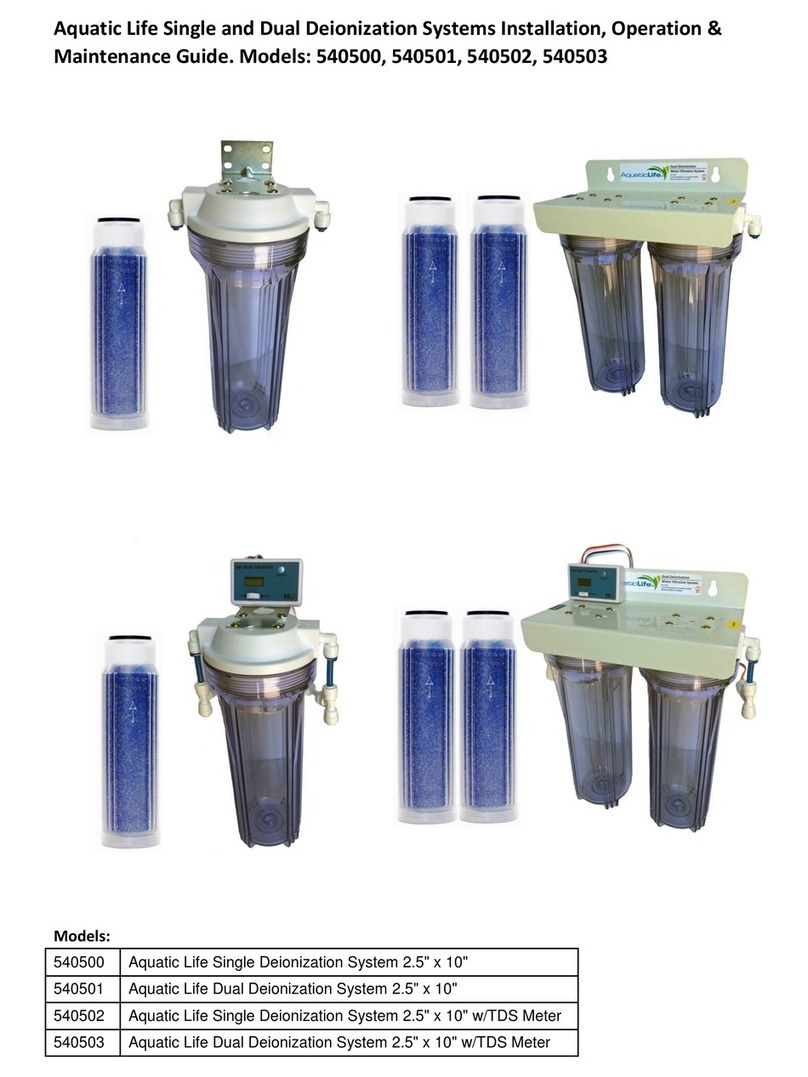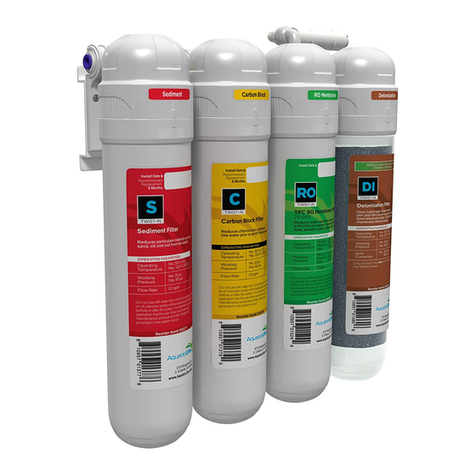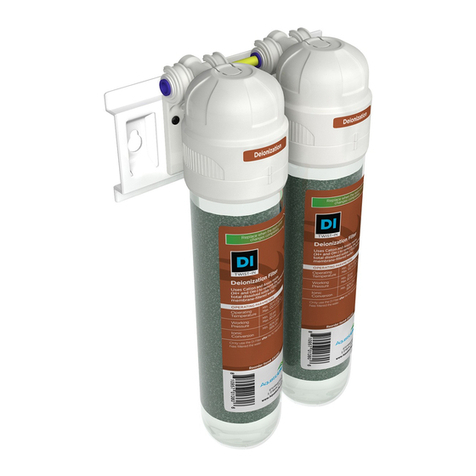
14 15
Classic Hydroponics 200 GPD
5-Stage RO Unit
Model# 540474
Installation, Operation & Maintenance Guide www.aquaticlife.com
REVERSE OSMOSIS
FILTER BASICS
The membrane does most of the work by
removing up to 98% of the TDS from your
water. The sediment and carbon filters protect
the membrane from the many malicious
elements that shorten its life. The sediment
cartridge removes suspended particles larger
than 5 microns (3 times smaller than a mold
spore). The carbon block removes chlorine.
Timely replacement of the cartridges will
increase the membrane’s life.
The carbon cartridge is the most important
cartridge to change frequently. The carbon
cartridge can filter about 3,500 gallons of
water before being replaced if your chlorine
level is 1 ppm (parts per million). With a
2 ppm you can filter 1,750 gallons of water
before needing to change, with a 3 ppm
you can filter 1,166 gallons, and so on. Any
chlorine not absorbed by a spent carbon
cartridge will break down your membrane,
thus greatly shortening its life.
The 3,500 gallon threshold is TOTAL water
that passes through the unit. The RO unit
has an average rejection ratio of 1:1.5.
That means for every 1 gallon of good water
produced you will reject 1.5 gallons for a total
of 2.5 gallons of water passed through the
unit.
When the sediment cartridge needs to be
changed, the production of water will reduce.
Even with reduced water production, the
cartridge will not allow anything larger than
one micron to pass through the chamber. On
average the sediment cartridge should be
changed at every other carbon change.
With proper filter changes, the membrane
could last up to two years. The membrane’s
water production rating is based on 77°F
water at 65 PSI. Any deviation from this
will aect the water production. Reference
the conversion table that follows. You will
notice that the warmer the water, the better
the production. It is not advised that you
introduce water from your water heater to
increase water temperature. The membrane
cannot handle temps over 100°F.
Example
The RO membrane production rate at 77ºF,
65 PSI = 200 gallons per day.
What is the production rate at 50º F?
Answer
Use the temperature correction factor
(from table above) = 0.58
New production flow rate at 50ºF is
200 x 0.58 = 116 gallons per day.
Temperature
Correction
Temp.
F/C
Correction
Factor
50/10 0.58
60/16 0.73
70/21 0.87
77/25 1.00
80/27 1.06
90/32 1.23
100/38 1.45
Pressure
Correction
Pressure
PSI
Correction
Factor
Less than 40 PSI
requires a
booster pump
40 0.67
50 0.83
65 1
70 1.17
80 1.33
UNIT MAINTENANCE
Weekly Maintenance
This unit includes a flush valve to prolong the
life of the membrane. IT IS IMPORTANT TO
PERIODICALLY OPEN THE FLUSH VALVE FOR
45 SECONDS PRIOR TO MAKING FILTERED
WATER. This will clear debris that may have
built-up on the membrane.
Recommended change 3-6 months
or 3,500 gallons total or 900 gallons
of filtered water
Sediment Cartridge (Item # 330088)
Carbon Cartridge (Item # 330090)
12 Month Maintenance
100 GPD Membrane Cartridge
(Item # 330093)
Replace Clear Canister & O-ring
(Part # 9000928)
NOTE: The life span of the
cartridges are dependent on
water supply quality and amount
of use. Our recommended
replacement intervals are based
on average usage.
CLOSED
OPEN
OPERATION & CONSIDERATIONS
The unit includes a pressure gauge to show
the incoming water pressure. Your target
pressure is 60- 65 PSI. You will produce less
filtered water if your water pressure is below
60 PSI. Pressure above 60 PSI may produce
more water. If the incoming water pressure
is less than 40 PSI, you will need to add a
booster pump.
• Operating the RO unit using soened feed
water greatly reduces the chances of
membrane failure.
• Clear canisters have a limited life and
should be replaced on an annual basis
to prevent possible failure.
• Operating pressure less than 40 PSI
may require a booster pump.
• Water supply operating pressure greater
than 80 PSI requires a pressure regulator.
• With initial operation, check for leaks.
If a leak is observed, verify that the
tubing is pushed into the push-fitting far
enough to seal the tubing against the
o-ring and that the canisters and caps
are sealed properly with their o-rings.
• Many of the components in this unit
are plastic and subject to damage by
ultraviolet light.
• Never store or operate the unit in direct
sunlight or other bright lights.
• Do not store or operate the unit in
temperatures above 100°F.
• Do not store or operate the unit in
freezing temperatures.
• Do not leave the unit unattended while
connected to a water supply.



